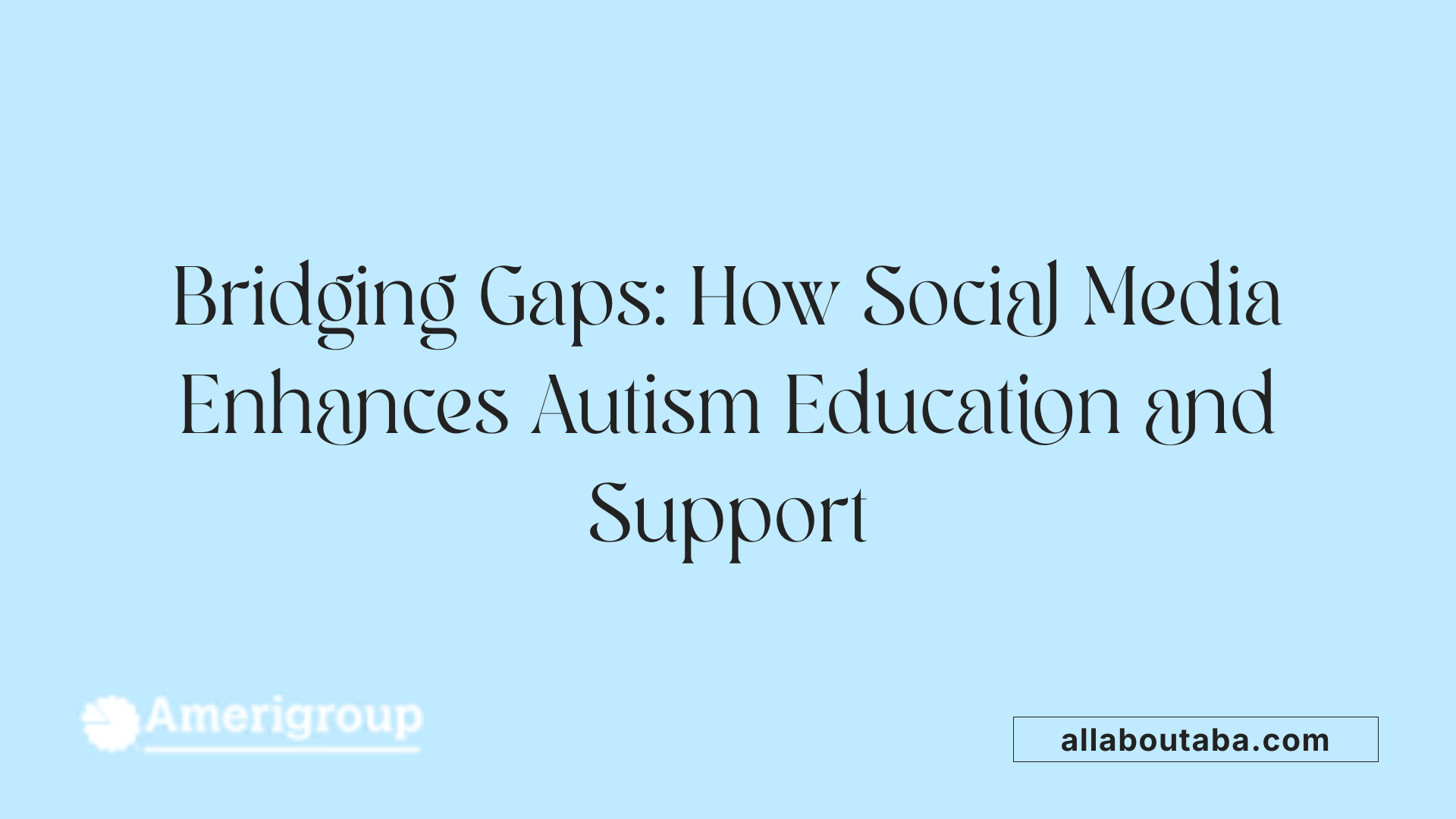Harnessing Digital Platforms to Foster Understanding and Support
In recent years, social media has emerged as a powerful tool in shaping public perceptions, promoting advocacy, and building communities for individuals on the autism spectrum. This article explores the multifaceted role of social media in autism awareness, highlighting how it serves as both a platform for education and a space for empowerment, despite presenting certain challenges.
Representation and Identity Development Online

How does social media influence autism advocacy and awareness?
Social media plays a critical role in shaping autism advocacy and increasing awareness. It offers a space for sharing personal experiences, educational resources, and defying misconceptions about ASD. Autistic individuals and allies use platforms like YouTube and Twitter to tell their stories and educate the public.
By doing so, social media helps reduce stigma and fosters understanding. Autistic advocates can rally support for policies like Conner’s Law, which aims to protect and empower individuals with autism. These platforms also help build supportive communities where members can find comfort, advice, and friendship across distances.
Despite its benefits, social media has challenges—such as occasional stereotypes and negative perceptions—that can affect how autism is viewed. Nonetheless, it significantly amplifies autistic voices and promotes acceptance.
The impact of online communities on self-esteem, self-acceptance, and identity for autistic individuals
Online communities positively influence how autistic individuals see themselves. Exposure to diverse representations and role models helps improve self-esteem and encourages self-acceptance.
Many participants report that interacting in these digital spaces validates their experiences and strengthens their understanding of their autism. The ability to connect anonymously or less publicly offers a safer environment to explore their identity without fear of judgment.
Sharing personal stories and engaging in peer support helps them develop a positive autism identity. This sense of belonging and acceptance can serve as a buffer against mental health struggles, fostering resilience and independence.
Differences in representation between online content and traditional sources
Traditional health sources often lack diversity, especially in representing adults and women with autism. They tend to focus on childhood and male presentations, which can lead to incomplete or skewed understanding.
In contrast, online content presents a broader spectrum of experiences. Autistic self-advocates create videos, blogs, and posts that highlight adult issues, gender differences, and personal journeys. This content offers a richer, more inclusive picture that challenges stereotypes.
However, there remains a need for official health information to become more diverse and representative. Improving visibility for women and adults with autism in mainstream sources would help promote a more accurate and respectful understanding across society.
| Aspect | Traditional Sources | Online Content | Notes |
|---|---|---|---|
| Representation | Limited, focus on children and males | Diverse, includes adults and women | Self-advocates share personal experiences |
| Accuracy | May be outdated or lacking detail | Real-time, personal insights | Enhances understanding of varied experiences |
| Inclusivity | Lacking gender and age diversity | Wide range of identities and ages | Promotes acceptance and self-awareness |
This comparison highlights the importance of increasing diversity across all platforms to support authentic representation and better serve the needs of the autistic community.
Limitations of Traditional Autism Resources and the Rise of Social Media
 Many autistic adults and their families find official health sources inadequate when seeking information about autism. These sources are often perceived as outdated, lacking in representation of adult experiences, especially for women with autism, and failing to reflect the diversity within the autism community.
Many autistic adults and their families find official health sources inadequate when seeking information about autism. These sources are often perceived as outdated, lacking in representation of adult experiences, especially for women with autism, and failing to reflect the diversity within the autism community.
Traditional materials may not address the nuanced needs of adults navigating autism later in life or provide inclusive perspectives that resonate across different genders and backgrounds. As a result, the information can feel irrelevant or incomplete, leaving many feeling underserved.
In contrast, social media has emerged as a vital platform for education and community building. It allows autistic individuals to share personal experiences, challenge stereotypes, and access up-to-date information. Platforms like YouTube and TikTok are especially effective in raising awareness by providing visual, relatable content about autism characteristics, interventions, and daily life.
Moreover, social media facilitates connections between autistic individuals, enabling peer support, advocacy, and resource sharing. Autistic self-advocates use these platforms to educate the public, highlight diverse perspectives, and promote acceptance.
To maximize its benefits, initiatives like social media literacy courses help autistic adults learn to navigate online spaces safely and responsibly. This approach ensures that social media serves as a tool for empowerment, breaking down barriers created by traditional resources.
| Aspect | Traditional Autism Resources | Social Media Role |
|---|---|---|
| Representation | Often limited, mainly focused on children and stereotyped images | Showcases diverse adult experiences, including women with autism |
| Relevance | Can be outdated or generalized | Offers current, real-world insights |
| Accessibility | Requires access to specific services or literature | Easily accessible anywhere with internet |
| Community Engagement | Less interactive, primarily informational | Promotes active participation, discussion, and peer support |
| Educational Impact | Limited to formal presentations or publications | Uses videos, personal stories, and advocacy to educate and inform |
Overall, social media fills critical gaps left by traditional sources, providing a more inclusive, dynamic, and accessible way for autistic individuals and the public to learn, connect, and foster understanding.
Online Communities: Support, Support Gaps, and Risks
What role does advocacy play in supporting autistic individuals through social media?
Advocacy is crucial in the online space for autistic individuals. Social media platforms empower autistic advocates to promote their rights, raise awareness, and challenge misconceptions about autism. By sharing personal experiences and educational content, they help create a more accepting and understanding environment.
These online platforms facilitate the development of positive identities by providing representation for groups often underrepresented in traditional media, such as women with autism. This visibility boosts self-esteem and acceptance for many autistic individuals.
Community support is another vital aspect. Autistic people can connect with others who share similar interests or experiences, which might be difficult in offline settings. Peer-to-peer mentoring and shared knowledge enhance community bonds, offering emotional support and practical advice.
Autoy advocates also use social media to influence public perceptions and recommend policy changes that favor inclusivity. Social media acts as a powerful tool for collective activism, mobilizing individuals around shared causes.
However, there are challenges. Online safety is a concern, including misinformation and hostile interactions. Ensuring these spaces are safe for autistic users requires proactive measures like supervision, privacy support, and promoting respectful communication.
In sum, advocacy through social media advances understanding, acceptance, and rights for autistic individuals. It provides a platform to share voices, build community, and inspire societal change, but must be managed carefully to maximize benefits and minimize risks.
Social Media's Role in Raising Autism Awareness Through Content
The use of platforms like YouTube to raise awareness about ASD.
Social media platforms, especially YouTube, have become powerful tools for sharing information and raising awareness about autism spectrum disorder (ASD). These platforms enable individuals to access a wide range of content that educates the public, dispels myths, and fosters empathy. YouTube, in particular, hosts a variety of videos created by autistic self-advocates, clinicians, and organizations addressing autism characteristics, diagnosis, and interventions. The platform’s visual and personal format allows viewers to connect emotionally with stories and factual information.
Types of content such as educational videos, personal stories, and comments.
Content on social media about autism encompasses educational videos that clarify misconceptions, personal testimonials that share lived experiences, and comment sections where viewers express support or ask questions. These videos often feature autistic individuals discussing their strengths, challenges, and daily life, providing insights that counter stereotypes. Comments serve as a space for feedback, support, and further discussion, with many viewers seeking to learn more or share their own stories.
Representation of diverse demographics and addressing biases.
While many videos focus on male and White individuals with autism, most content highlights prevalent demographic groups. This focus reflects epidemiological data but can inadvertently reinforce stereotypes if diverse populations are underrepresented. Increasing representation of women, people of color, and adults across social media content is essential to creating a broader understanding of the spectrum and combating biases. Addressing misconceptions and promoting inclusivity in these platforms helps improve societal acceptance and supports diverse autistic voices.
Risks of misinformation or misconceptions about autism on social media platforms?
Despite the benefits, social media also poses significant risks. Studies indicate that only about 27% of popular autism videos on platforms like TikTok provide accurate and scientifically valid information. Many mislead viewers with false or oversimplified claims, such as linking vaccines to autism or promoting unproven interventions. Misinformation may lead to harmful stereotypes, encourage self-diagnosis without professional assessments, and delay access to appropriate care. Therefore, consumers should critically evaluate content and rely on authoritative sources to ensure they receive accurate information about autism.
Amplification of Autistic Voices and Self-Advocacy in Social Media
Why is self-advocacy important for autistic individuals?
Self-advocacy empowers autistic people to speak up for themselves, make decisions about their lives, and access the support and resources they need. It fosters independence and helps individuals express their identity confidently. As awareness grows, autistic advocates challenge stereotypes and push for societal changes that promote inclusion and understanding.
How is social media used to raise awareness and educate?
Social media platforms serve as powerful tools for sharing personal stories, raising awareness, and educating the public about autism. Autistic individuals and allies post videos, blogs, and infographics to dispel misconceptions and promote acceptance. Campaigns often address stereotypes, highlight strengths, and advocate for policy changes.
Can you give examples of successful campaigns and influential advocates?
Several campaigns have gained significant attention and impacted public perception:
- #NowIKnow: Launched by the National Autistic Society, this campaign shares stories of late-diagnosed autistic women and non-binary people to foster understanding.
- Vanish: Me, My Autism & I: This short film by Ambitious about Autism highlights experiences of autistic girls, aiming to increase awareness.
- The Greatest: Apple’s campaign spotlighted how disabled users leverage accessibility features, promoting inclusivity.
- Accessible Card Campaign: Microsoft’s initiative promoted digital inclusion for the visually impaired.
- Sign With Fingers: Cadbury Fingers’ campaign used sign language gestures to raise awareness about communication disabilities.
Influential advocates include autistic self-advocates who regularly share their experiences online, challenge misconceptions, and participate in awareness events. Their voices contribute to cultivating a more accepting society.
| Campaign Name | Focus Area | Notable Impact | Supporting Organizations |
|---|---|---|---|
| #NowIKnow | Awareness for late-diagnosed adults | Increased visibility for marginalized groups | National Autistic Society |
| Vanish | Girls on Autism Spectrum | Broader understanding of gender differences | Ambitious about Autism |
| The Greatest | Accessibility Technologies | Promoted tech for inclusion | Apple |
| Sign With Fingers | Communication Disabilities | Promoted sign language awareness | Cadbury |
By leveraging social media, autistic advocates and organizations amplify their messages, fostering greater acceptance and understanding across communities.
Addressing Misinformation and Promoting Responsible Use
Are there risks of misinformation or misconceptions about autism on social media platforms?
Yes, social media platforms like TikTok and YouTube do present significant risks when it comes to false information, stereotypes, and harmful myths about autism. Research indicates that only around 27% of popular videos related to autism offer accurate, evidence-based information. The rest can be misleading, overgeneralized, or outright false.
Among the most problematic myths are those linking vaccines directly to autism, which have been thoroughly debunked by scientific studies. Such misconceptions not only spread misinformation but also influence public perception negatively. They can lead to harmful self-diagnosis, delays in seeking professional assessment, and reinforce stereotypes about autistic individuals.
Misinformation on social media is powerful because content can reach millions within a short span, shaping societal attitudes and individual self-awareness in unhelpful ways. This can deepen misunderstandings and create barriers to acceptance.
Therefore, it is crucial for autistic individuals, families, educators, and the general public to rely on reputable, verified sources. Consulting healthcare professionals, autism specialists, and organizations like the Autism Society ensures access to accurate, current, and nuanced information.
Promoting media literacy and critical thinking about online content can help users discern trustworthy information from myths. Platforms can also play a role by flagging false information and promoting credible sources. Ultimately, fostering an informed community helps build understanding and acceptance of autism based on facts rather than misconceptions.
Supporting Autistic Communication and Social Interaction in the Digital Age
How does social media shape perception and identity within autistic communities?
Social media has become a powerful tool for autistic individuals to explore and affirm their identities. It offers a platform where they can share personal experiences and access positive representations of autism, which are often missing from traditional health sources. Through online communities, autistic adults and youth find role models, diverse perspectives, and a space to discuss their experiences openly.
Platforms like YouTube and social network sites facilitate awareness and understanding by showcasing educational content and personal stories. These stories can challenge stereotypes, reduce stigma, and foster empathy among viewers. For many autistic individuals, seeing themselves reflected in online content helps improve self-esteem and promotes self-acceptance.
Despite some concerns about misinformation and online hostility, the overall impact of social media in shaping perceptions remains positive. It provides a sense of belonging and validation for those who might feel isolated offline, especially women and adults with autism, who are often underrepresented in official resources. Social media’s inclusive environment supports the development of a stronger positive autism identity, which can act as a buffer against mental health challenges.
In summary, social media shapes perceptions and identity within autistic communities by fostering representation, connection, and understanding. It amplifies autistic voices, offers educational insights, and helps individuals navigate their journey toward self-awareness and acceptance.
The Future of Autism Advocacy: Digital Strategies and Inclusive Approaches
How can social media be used to influence policy and engage the public?
Social media stands as a powerful tool for advocating policy changes and rallying public support for autism rights. By sharing personal stories, organizing campaigns, and mobilizing communities, autistic individuals and allies can draw attention to issues such as funding for services, accessibility, and inclusive education.
Platforms like Twitter, Facebook, and Instagram enable advocates to reach broad audiences, influence policymakers, and foster grassroots movements. Hashtags and viral content can highlight systemic gaps and push for legislative action, making social media a catalyst for real-world change.
Why is diverse, inclusive content important in autism online communities?
Representation matters greatly in shaping perceptions and self-identity among autistic individuals. Content that reflects the diverse experiences of women, adults, and people from various cultural backgrounds helps combat stereotypes and promotes understanding.
Creating and sharing stories that showcase different ways of living with autism fosters a more realistic and compassionate society. Inclusive media not only enriches understanding but also empowers marginalized groups within the autism community to see themselves reflected and valued.
What are responsible online spaces and educational programs for autism?
Developing safe, respectful, and well-informed online environments is crucial. This includes moderation to prevent harassment, clear guidelines to promote respectful communication, and features that support accessibility, such as content transcription.
Educational programs focused on responsible social media use can teach autistic users about privacy, digital etiquette, and managing online interactions. Pampering safe spaces for autistic individuals to share and learn ensures that social media benefits outweigh the potential risks.
| Strategy | Focus | Outcomes | Role in Future Advocacy |
|---|---|---|---|
| Policy campaigns | Public engagement | Policy changes | Amplifies autistic voices in policymaking |
| Inclusive content | Diversity in representation | Break stereotypes | Encourages self-acceptance and societal understanding |
| Responsible digital spaces | Safety & education | Reduces harassment risks | Builds trust and promotes healthy online communities |
Effective autism advocacy will rely on leveraging digital platforms responsibly and inclusively, ensuring that online spaces serve as engines of awareness, acceptance, and policy progress.
Harnessing the Power of Social Media for a More Inclusive Future
Social media has revolutionized autism advocacy and awareness by providing platforms for representation, education, and community building. While it presents remarkable opportunities to amplify autistic voices and foster understanding, challenges related to misinformation, online safety, and diverse representation remain. Moving forward, a collaborative effort involving autistic communities, educators, policymakers, and platform providers is essential to harness social media's full potential. By promoting responsible use, ensuring inclusive content, and fostering respectful online environments, social media can serve as a powerful force for societal change—advocating for acceptance, understanding, and the full inclusion of autistic individuals in all aspects of life.
References
- Social media shaping autism perception and identity - PMC
- Social media offers benefits for autistic community | Autism Speaks
- Social Media Use and Autism - Teens and Adults
- The Influence of Social Media on the Perception of Autism Spectrum ...
- The Role of Self-Advocacy in the Autism Community
- Use of social network sites among adolescents with autism spectrum ...
- Autism and communication - National Autistic Society
- The Influence of Social Media on the Perception of Autism Spectrum ...
- Social media offers benefits for autistic community | Autism Speaks
- Social media shaping autism perception and identity - PMC







